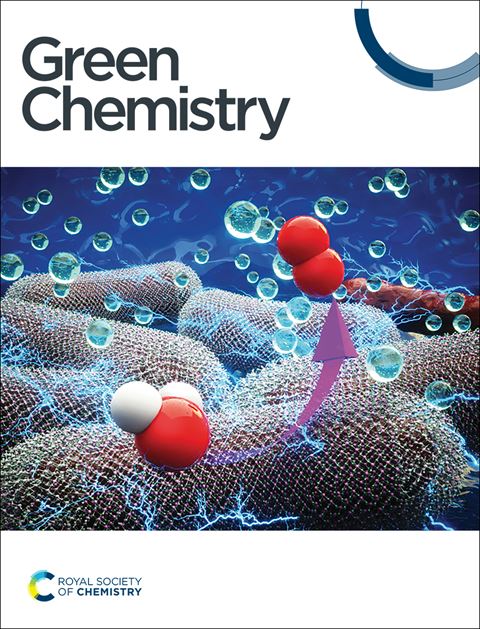Upcycling atmospheric CO2 to polyhydroxyalkanoates via sequential chemo-biocatalytic processes†
IF 9.2
1区 化学
Q1 CHEMISTRY, MULTIDISCIPLINARY
引用次数: 0
Abstract
The reduction of greenhouse gas emissions and the shift away from petrochemical-derived materials are critical goals in modern industrial development and societal progress. Addressing these intertwined challenges demands innovative and sustainable solutions. Here, we present the first example of synthesizing poly[R-(–)-3-hydroxybutyrate] (PHB) from atmospheric CO2, utilizing a streamlined and integrated process that combines both chemo- and bio-catalytic conditions. Central to our approach is the development of an immobilized catalytic system that efficiently converts atmospheric CO2 into sodium formate, establishing a sustainable carbon source for formatotrophic organisms. Through Adaptive Laboratory Evolution (ALE), we enhanced the growth rate of the bacterium Cupriavidus necator H16, enabling it to utilize formic acid and formate as the sole carbon and energy sources. The evolved strain, C. necator ALE26, achieved a 1.8-fold increase in the maximum growth rate (μmax = 0.25 ± 0.02 h−1), attributed to the loss of the megaplasmid pHG1. Employing the adapted strain, we report the highest PHB production rate in continuous fermentation using C. necator for growth on formate. The development of the different stages (sorption and chemo- and bio-transformation) under compatible conditions that minimize the number of work-up stages demonstrates a major advancement in converting atmospheric CO2 into valuable biopolymers, thus simultaneously contributing to the reduction of greenhouse gases in the atmosphere and to a circular economy of biobased polymers that diminish fossil fuel dependence.

通过顺序化学-生物催化过程将大气中的二氧化碳升级为聚羟基烷酸酯
减少温室气体排放和远离石化衍生材料是现代工业发展和社会进步的关键目标。应对这些相互交织的挑战需要创新和可持续的解决方案。在这里,我们提出了从大气CO2中合成聚[R-(-)-3-羟基丁酸盐](PHB)的第一个例子,利用一个结合化学和生物催化条件的流线型和集成工艺。我们方法的核心是开发一种固定化催化系统,有效地将大气中的二氧化碳转化为甲酸钠,为甲酸营养型生物建立可持续的碳源。通过适应性实验室进化(ALE),我们提高了Cupriavidus necator H16的生长速度,使其能够利用甲酸和甲酸作为唯一的碳和能量来源。进化菌株C. necator ALE26的最大生长率提高了1.8倍(μmax = 0.25±0.02 h−1),这是由于丢失了大质粒pHG1。采用适应菌株,我们报告了用C. necator在甲酸盐上生长的连续发酵中PHB的产量最高。不同阶段(吸附、化学和生物转化)在兼容条件下的发展,最大限度地减少了加工阶段的数量,这表明在将大气中的二氧化碳转化为有价值的生物聚合物方面取得了重大进展,从而同时有助于减少大气中的温室气体,并促进生物基聚合物的循环经济,减少对化石燃料的依赖。
本文章由计算机程序翻译,如有差异,请以英文原文为准。
求助全文
约1分钟内获得全文
求助全文
来源期刊

Green Chemistry
化学-化学综合
CiteScore
16.10
自引率
7.10%
发文量
677
审稿时长
1.4 months
期刊介绍:
Green Chemistry is a journal that provides a unique forum for the publication of innovative research on the development of alternative green and sustainable technologies. The scope of Green Chemistry is based on the definition proposed by Anastas and Warner (Green Chemistry: Theory and Practice, P T Anastas and J C Warner, Oxford University Press, Oxford, 1998), which defines green chemistry as the utilisation of a set of principles that reduces or eliminates the use or generation of hazardous substances in the design, manufacture and application of chemical products. Green Chemistry aims to reduce the environmental impact of the chemical enterprise by developing a technology base that is inherently non-toxic to living things and the environment. The journal welcomes submissions on all aspects of research relating to this endeavor and publishes original and significant cutting-edge research that is likely to be of wide general appeal. For a work to be published, it must present a significant advance in green chemistry, including a comparison with existing methods and a demonstration of advantages over those methods.
 求助内容:
求助内容: 应助结果提醒方式:
应助结果提醒方式:


